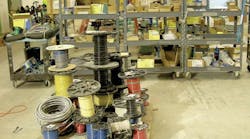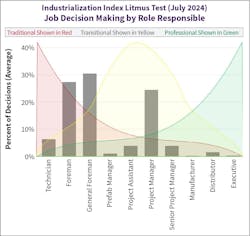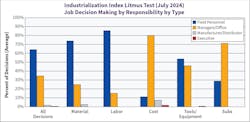How often do you find yourself up three flights of stairs, tools and material in tow, only to realize you are missing a part and need to make another trip? Or worse, how often do you or members of your crew realize midway through a task that someone needs to go pick up material at the shop or supply house to finish the job? If you run into this regularly, you are not alone.
A study conducted by MCA on the ideal job-site inventory levels to improve productivity showed that 40% of electricians’ time is spent on material handling (Fig. 1). Material handling includes moving material from one location to another, ordering material, looking for material, organizing materials, and manipulating materials on the site. More time on material handling means less time on productive installation work. Your leads in the field will get the job done — and focusing on what their skill is (electrical installation) is the best for your job and company. Leave the logistics to the distributors, and move the planning upstream to the project managers (PMs) who have full responsibility for the profits on the job.
So, why is this the case?
MCA’s research offers a few reasons why you may experience unwanted time spent on material handling, and it isn’t because you or your field leads are forgetful or unorganized. To understand why material handling might be happening on your job, consider:
- How does your company handle decision-making for job-related issues and topics? Who is primarily responsible for deciding, for example, where material is stored? When does this decision happen?
- How far in advance do you order material? A day? A week?
Material decision making
In the 2021 EC&M job-site intelligence article called “Invisible Decisions,” MCA talked about how much decision making and problem-solving happens in the field on a typical job site. The article cites Dr. Heather Moore’s 2013 thesis, “Exploring Information Generation and Propagation from the Point of Installation on Construction Jobsites,” which showed that obstacles experienced in the field are reported only about 50% of the time. Since 2021, MCA has continued its research on this topic of job decision making and what it means for Industrialization of Construction® through regular updates to the Industrialization Index Litmus Test®. Take the test here.
The litmus test, which was discussed in EC&M’s “Invisible Decisions — Part 2” article, provides contractors a way to evaluate decision making across different areas in managing a job – including labor, material, tools/equipment, and subcontractor-related decisions — and the results provide insight for the industry on how contractors are transitioning from a traditional to a professional business model.
Placing work in the hands of the company that is best suited for planning, decision making, and execution will help your bottom line. MCA’s July 2024 litmus test (Fig. 2) shows that the general foreman and the on-site foreman are responsible for the highest percentage of decisions — 31% and 27%, respectively.
Looking specifically at material decisions, (including decisions about material movement, manipulation before installation, receiving, storing, and returning materials), field personnel are exceedingly either empowered or left responsible. Figure 3 shows that field personnel (including technicians, foreman, and general foreman) are, on average, responsible for 73% of decisions regarding material.
Why does this matter? Your leads will order what they need (or maybe more) from whoever is closest to them or they have a relationship with — and maybe not via the channel of the deal you as the estimator or PM have negotiated pricing. The time they spend ordering material reduces the time they could spend planning for the installation work and leading their crews on the job. Consider working with your distributor to have them support your material movement needs as well by giving them advance notice of what you need. Material decisions are higher than any other type of decision in terms of reliance on the technician/skilled trade, indicating that contractors’ approach to material decision making is still predominately traditional, despite the movement toward the transitional model industry-wide.
Considerations in planning for material
To assess if your company or project has a more traditional approach to decision making, you can complete the litmus test with your team, which will give you an idea of the current situation in your company. From there, you can use the litmus test framework to clarify who is responsible for what. This alone can reduce ambiguity, and it can ultimately reduce the potential miscommunication that leads to things like over-ordering of material, time spent looking for material, and extra trips to the vendor. Once responsibilities are defined, each assigned role can lead the charge in developing a plan for the portion they are responsible for.
Once roles are defined, the team can use tools like Work Breakdown Structure (WBS) to build out the plan for the work (including the tasks involved in getting the material to the point of installation). The WBS process consists of defining all of the work to complete a project and breaking it down into manageable scopes. This ensures that nothing is missed and everything is explicit. Some material and logistics items that your WBS should consider are:
- How often will material be ordered?
- How will inventory be managed for miscellaneous items?
- When is the material needed on the job site?
- Does it need to be stored off site during the duration of the job? Can it be stored at a distributor facility and delivered as needed?
- How will the material be labeled?
- Where will the material be delivered to the job site?
- How will it be received? Where will it be received? What tools are needed for receiving and getting it to the next location?
- How will it get to the point of installation?
- What manipulation is necessary? Can this be completed before it comes to the job site?
- If returns are needed, who is responsible for making sure they are processed?
- How much work is involved in removing packaging? Can this be done by the vendor in advance?
While material-related decisions may not be the most glamorous, they are critical to your company’s performance and your team’s ability to get their jobs done. By clearly defining decision-making responsibilities and creating a thorough plan for each element of the job-site logistics early on, you can get the material to the point of installation when, where, and how it is needed by leaning on those with the best knowledge of the overall project — and using the resources of those that are experts in logistics and material movement (i.e., the distributor).






